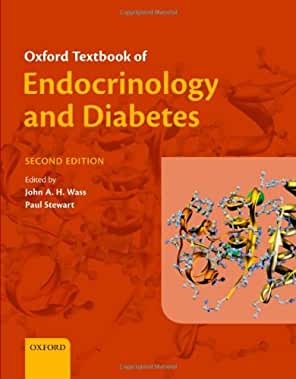图书简介
Now in its second edition, the Oxford Textbook of Endocrinology and Diabetes is a fully comprehensive, evidence-based, and highly-valued reference work combining basic science with clinical guidance, and providing first rate advice on diagnosis and treatment.
Principles of international endocrine Practice; 1.1 A history of endocrinology; 1.2 Prevention in endocrinology; 1.3 Endocrinology and evolution: lessons from comparative endocrinology; 1.4 Hormones and receptors: fundamental considerations; 1.5 Molecular basis of hormonal action; 1.6 Endocrine autoimmunity; 1.7 Measurement of circulating hormones; 1.8 Endocrine disruptors; 1.9 Sports endocrinology; Pituitary and hypothalmic diseases; 2.1 Pituitary anatomy and physiology; 2.2 The neurohypophysis; 2.3 Aetiology, pathogenesis, and management of disease of the pituitary; 2.4 Aetiology, pathogenesis, and management of disease of the hypothalamus; 2.5 Pineal physiology and pathophysiology including pineal tumours; 2.6 Neuropsychiatric endocrinological disorders; The thyroid; 3.1 Evaluation of the thyroid patient; 3.2 Aetiology of thryroid disorders; 3.3 Thyrotoxicosis and related disorders; 3.4 Hypothyroidism and pregancy- and growth-related thyroid disorders; 3.5 Thyroid lumps; Parathyroid, calcium and bone metabolism; 4.1 Parathyroid anatomy, hormone synthesis, secretion, action, receptors; 4.2 Hypercalcaemia; 4.3 Primary hyperparathyroidism; 4.4 Familial hypocalciuric hypercalcaemia; 4.5 Hypocalcaemic disorders, hypoparathyroidism, and pseudohypoparathyroidism; 4.6 Hypercalcaemic and hypocalcaemic syndromes in children; 4.7 Osteoporosis; 4.8 Thyroid disease and osteoporosis; 4.9 Paget?s disease of bone; 4.10 Rickets and osteomalacia (acquired and heritable forms) and skeletal dysplasias; 4.11 Glucocorticoid induced osteoporosis; The adrenal gland and endocrine hypertension; 5.1 Adrenal imaging; 5.2 Adrenal surgery; 5.3 Adrenal incidentaloma; 5.4 Adrenocortical cancer; 5.5 Phaeochromocytomas, paragangliomas, and neuroblastoma; 5.6 Primary aldosteronism and other steriod-related causes of endocrine hypertension; 5.7 Cushing?s syndrome; 5.8 Glucocorticoid resistance - the defect in glucocorticoid receptor; 5.9 Addison?s disease (adrenal insufficiency); 5.10 Familial glucocorticoid deficiency syndromes- the defect ACTH receptor; 5.11 Congenital adrenal hyperplasia; Neuroendocrine tumours and genetic disorders; 6.1 An appraisal of the past and perspectives for the future; 6.2 Neuroendocrine tumour markers; 6.3 Neuroendocrine (carcinoid) tumours and the carcinoid syndrome; 6.4 Gastrinoma; 6.5 Insulinomas and hypoglycaemia; 6.6 Glucagonoma; 6.7 VIPomas; 6.8 Somatostatinomas; 6.9 Imaging neuroendocrine tumours of the gastrointestinal tract; 6.10 Mastocytosis; 6.11 MEN1; 6.12 MEN2; 6.13 Von Hippel-Lindau disease and succinate dehydrogenase subunit (SDHB, SDHC and SDHD) genes; 6.14 Neurofibromatosis; 6.15 Carney?s complex; 6.16 Molecular and clinical characteristics of McCune Albrights syndrome; 6.17 Cowden?s syndrome; Growth and development during childhood; 7.1 Normal growth and sexual development; 7.2 Growth and sexual disorders in childhood; Female endocrinology and pregnancy; 8.1 Female endocrinology and ovarian disorders; 8.2 Pregancy-related disorders; Male endocrinology; 9.1 Definitions and classifications of disorders; 9.2 Normal male endocrinology; 9.3 Evaluation of the male patient with suspected endocrinological disease; 9.4 Male endocrinological disorders and male factor infertility; 9.5 Exogenous factors and male reproductive health; Endocrinology of ageing and systemic disease; 10.1 Ageing and the endocrine system; 10.2 Endocrinology of systemic disease; Endocrinology of cancer; 11.1 Secondary endocrine tumours, ectopic hormone syndromes, and effects of cancer treatment on endocrine function; 11.2 Hormonal therapy for breast and prostatic cancers; Obesity, lipids and metabolic disorders; 12.1 Epidemiology, aetiology, and management of obesity; 12.2 Lipoprotein metabolism and related diseases; 12.3 Other metabolic disorders; Diabetes mellitus; 13.1 Diagnosis and classification of diabetes mellitus; 13.2 Aetiology and pathogenesis of type 1 diabetes mellitus; 13.3 Aetiolology and pathogenesis of type 2 diabetes mellitus; 13.4 Management of diabetes mellitus; 13.5 Microvascular complications; 13.6 Macrovascular diseases and diabetes mellitus; 13.7 The diabetic foot; 13.8 Mental health in diabetes mellitus; 13.9 Organisation of diabetes care
Trade Policy 买家须知
- 关于产品:
- ● 正版保障:本网站隶属于中国国际图书贸易集团公司,确保所有图书都是100%正版。
- ● 环保纸张:进口图书大多使用的都是环保轻型张,颜色偏黄,重量比较轻。
- ● 毛边版:即书翻页的地方,故意做成了参差不齐的样子,一般为精装版,更具收藏价值。
关于退换货:- 由于预订产品的特殊性,采购订单正式发订后,买方不得无故取消全部或部分产品的订购。
- 由于进口图书的特殊性,发生以下情况的,请直接拒收货物,由快递返回:
- ● 外包装破损/发错货/少发货/图书外观破损/图书配件不全(例如:光盘等)
并请在工作日通过电话400-008-1110联系我们。
- 签收后,如发生以下情况,请在签收后的5个工作日内联系客服办理退换货:
- ● 缺页/错页/错印/脱线
关于发货时间:- 一般情况下:
- ●【现货】 下单后48小时内由北京(库房)发出快递。
- ●【预订】【预售】下单后国外发货,到货时间预计5-8周左右,店铺默认中通快递,如需顺丰快递邮费到付。
- ● 需要开具发票的客户,发货时间可能在上述基础上再延后1-2个工作日(紧急发票需求,请联系010-68433105/3213);
- ● 如遇其他特殊原因,对发货时间有影响的,我们会第一时间在网站公告,敬请留意。
关于到货时间:- 由于进口图书入境入库后,都是委托第三方快递发货,所以我们只能保证在规定时间内发出,但无法为您保证确切的到货时间。
- ● 主要城市一般2-4天
- ● 偏远地区一般4-7天
关于接听咨询电话的时间:- 010-68433105/3213正常接听咨询电话的时间为:周一至周五上午8:30~下午5:00,周六、日及法定节假日休息,将无法接听来电,敬请谅解。
- 其它时间您也可以通过邮件联系我们:customer@readgo.cn,工作日会优先处理。
关于快递:- ● 已付款订单:主要由中通、宅急送负责派送,订单进度查询请拨打010-68433105/3213。
本书暂无推荐
本书暂无推荐















